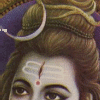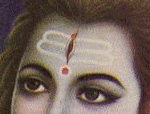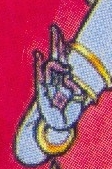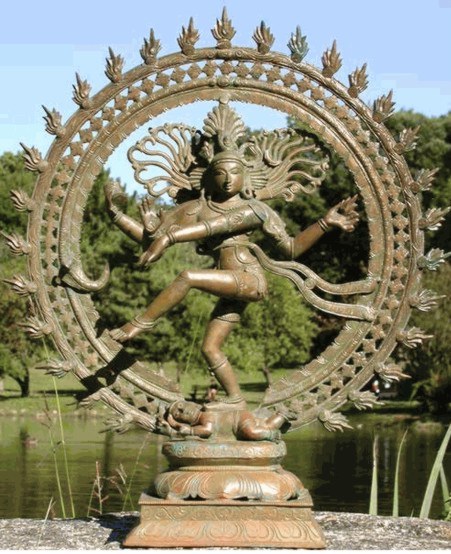 |
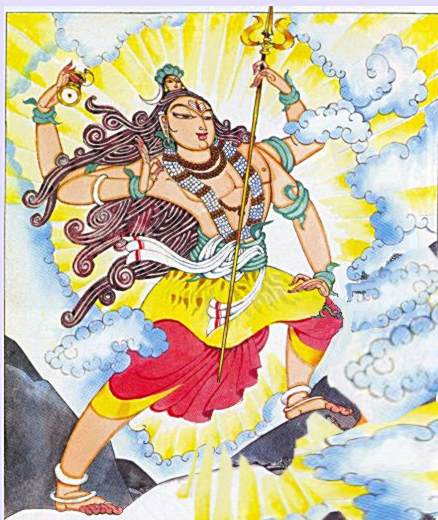 |
|
Nataraja is the Cosmic Dancer. Nothing remains static in dance, or to that matter of fact, in any performing art. That dynamsm is identifiable with naTana, not exactly playuacting, but 'doing something' 'dynamism' is metophorically termed as naTana, or for an easy identification, 'dance' of shiva, and this dynamism is the manifestation of the entire universe.
The manifestation, maintenance, and dissolution of the entire universe being dynamic, it is represented in shiva's dsances. and he does various kinds of 'dances' for the uplkeep of karmic cycle. Iconographically, he is depicted to be performing various dances at various stages of the existence of universe. This is one among the twenty five types of iconographic representations of shiva.
His dance itself is the personification of his eternal dynamism of
the universe, and that dance, or the stage of universe is arranged
into five categories: (1) adbhuta taanDava
- amazing dance, amazing causation of universe; (2)
aananda taanDava - blissful dance -
blisful existnce of universe; (3) anavarata
taanDava - incessant dance - incessant nature of universe;
(4) samhaara taanDava - elimination
time dance; (5) pralaya taanDava -
dissolution time dance.
The fifth kind of dance is associated with rudra, the annihilator. shiva's name is five lettered panchakshari. The five syllables are na, maH, shi, va, ya and recited as Om namaH shivaayaH, and this is indicative of five capabilities for the divine functions, pancha kriyaa shakti-s namely, sR^iSTi- creation; sthithi - maintenance; samhaara - destruction; tirobhaava - illusive; and anugraha - blessing. The five elements of creation, pR^iithivi, aapa, teja, vaayu, aakaasha, viz. solidity, liquidity, fire, ether, air, are also denoted by this five lettered name of shiva, which are the essential elements for formation of any being, either living or material.
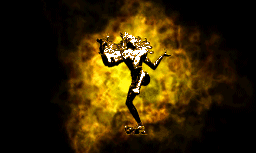 Nataraja is encircled by the ever glowing and flaming Cosmic
Circle, which is termed as jwaala maala prabha
maNDala, where jwaala = tongues
of flames ; maala = garland [of
flames]; prabha = glowing;
maNDala= nimbus - a nimbus of a garland
of tongues of glowing flames - surrounding the entire cosmos.
Nataraja is encircled by the ever glowing and flaming Cosmic
Circle, which is termed as jwaala maala prabha
maNDala, where jwaala = tongues
of flames ; maala = garland [of
flames]; prabha = glowing;
maNDala= nimbus - a nimbus of a garland
of tongues of glowing flames - surrounding the entire cosmos.
Nataraja is the embodiment of the resplendence of ever burning, flickering, glowing Cosmic flames like a garland around the deity. This whole universe is filled by him. The entire aspect is to be visualised as dynamism, radiance and glow of the Cosmic Fire, which is present ever and anon.
Nataraja need not be taken iconographically as a dancing god or a god who is designated for destruction. The Cosmic Being, Nataraja, is garlanded by the clusters of galaxies that glow and flicker like heavenly flowers. This Cosmic Entity is depicted by the arch around Nataraja, and with icons of flames studded therein. This glowing galactic circular arch around Nataraja is deciphered as OM, where OM is the sonic source of all the uttered words, to be used later by the living beings for communicating their pains and pleasures.
Nataraja's head is adorned with tufts of hairlocks, in which the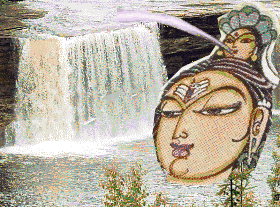 ferocious, fleeting River Ganga is locked . Though locked up,
Ganga is allowed an ordinary flow like any other river, thus she
gave pasture lands to the peasantry. Ganga in the hairlocks of
Nataraja represents sampat samvR^iddhi,
where sampat is wealth;
sam vR^ddhi is abundance. Thus River
Ganga is an ever growing phenomena of according abundant wealth
and material prosperity.
ferocious, fleeting River Ganga is locked . Though locked up,
Ganga is allowed an ordinary flow like any other river, thus she
gave pasture lands to the peasantry. Ganga in the hairlocks of
Nataraja represents sampat samvR^iddhi,
where sampat is wealth;
sam vR^ddhi is abundance. Thus River
Ganga is an ever growing phenomena of according abundant wealth
and material prosperity.
As a perennial river from the Himalaya mountains, Ganga is flowing across the country, enriching the natural resources of the country, even today, and hence she is revered as a goddess.
There is a Crescent Moon in these tufts of Nataraja. This moon is in the rising order to become a full moon, This chandra rekha; chandra = moon; rekha = crescent; is there for anugraha i.e., to bestow; to bestow the material pleasures. The Moon is also the deity of Time, according as his increasing / decreasing digits. Thus, Nataraja is designated as the presiding deity of Time, and called mahaa kaala or tri kaala, where kaala is time. Because he created the immeasurable time, he is regarded as a god who controls the time factor of living beings, hence shiva resorts to dissolution at the end.
shiva has three eyes. Of which one is suurya = Sun; the other is chandra = moon; while the third eye is j~naana netra = wisdom eye. This third eye is in the centre of the forehead. Here is where the Hindus apply a decorative vermilion color spot, kumkum or tilak, lest the wise eye might see unwise things in the life.
Draw an imaginary line from here through to the centre of the brain. There is pituitary in there. It does the same function as that of the wise eye. The attributes of sun and moon to two eyes symbolise the light and darkness, good and bad, greed and content, or any pairs of opposites. But the wise eye shall pre-process this objective material before passing it to the central processor, the decision making manas = conscience. While these three are just the attributes to the Cosmic Being, the real living beings will also have these three eyes, physically and psychologically.
On the right ear lobe of Nataraja, there hangs an ear ring called
makara kuNDala;
makara = crocodile;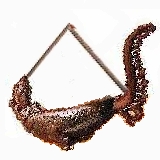 kuNDala = ear-knob hanging. A golden
ear hanging in the shape of a crocodile, usually worn by males
will be there on the right ear of shiva. This denotes
shiva's sagaciousness, as such he is the Supreme guru - in his
manifestation as dakshniNAmUrty.
kuNDala = ear-knob hanging. A golden
ear hanging in the shape of a crocodile, usually worn by males
will be there on the right ear of shiva. This denotes
shiva's sagaciousness, as such he is the Supreme guru - in his
manifestation as dakshniNAmUrty.
In the bygone centuries the pundits were awarded with the certain ornaments to let others recognise them as pundits of some order. The then universities of traditional education used to award Kashmiri shawls of a particular color, say green to one level, and red to higher level and gold or silver embroidered shawls to highest level of pundits. There were bracelets and anklets also, called simhatalata-s golden bracelet with lion's head crafted on it. And anklets called gaNDa penDera-s. They were the ornaments of that day to indicate the social status of wellread pundits. The face being the index of the mind, the ear ring is the subscript of that mind's IQ. These ear rings were also graded according to their studded diamonds, emerald or rubies, to indicate the educational grade with which they are bestowed.
shiva is the supreme symbol in education, which is symbolised by this ear-hanging on right ear.
While elucidating the guru attributes of shiva, the scripts call
him dakshniNAmUrty. In sculputures and
images we will be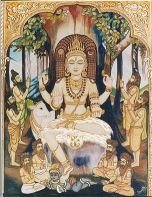 generaly seeing a picture of a young guru teaching octogenarian
students under a big bayan tree, ashwattha
vR^iksha, and we get a laugh about such a reversal of
depiction. The teacher in such pictures is shiva in his role of
supreme guru, called dakshniNAmUrty,
and the silver-bearded students are the wisom-hungry sages and
saints. Supreme intellect is always young and imparts wisdom
untiringly, which is to be received properly at any age.
generaly seeing a picture of a young guru teaching octogenarian
students under a big bayan tree, ashwattha
vR^iksha, and we get a laugh about such a reversal of
depiction. The teacher in such pictures is shiva in his role of
supreme guru, called dakshniNAmUrty,
and the silver-bearded students are the wisom-hungry sages and
saints. Supreme intellect is always young and imparts wisdom
untiringly, which is to be received properly at any age.
Apart from punditry, Nataraja's single makara kuNDala of males on one earlobe, and an eloborate earhanging worn by females on the other earlobe, indicates his half-male-half-female entity. It indicates that his right half is a masculine while the left is a female - symbolised as artha naariishvar concept.
On the left earlobe hangs an earhanging, called
taaTanka, which is the jewellery of
females, The earhanging of ladies will not indicate scholarly
status, but have beauty and decorative values. Hence
 taaTanka on left earlobe is symbol for
a divine feminine beauty. Thus the feminity of left side of
shiva's body is indicated, suggesting that he is both male and
female, artha narii iishwara -
artha = half; naari
= female; iishwara = lordship;
he is both the lord and the lady.
taaTanka on left earlobe is symbol for
a divine feminine beauty. Thus the feminity of left side of
shiva's body is indicated, suggesting that he is both male and
female, artha narii iishwara -
artha = half; naari
= female; iishwara = lordship;
he is both the lord and the lady.
This "halfness " is not attributable to iishwara. If done so, he will become half God. As Supreme Being is not described thus, but it is said that a female is his part - say the better half - is contained in him. He is not some entity made up of parts, but he created parts from himself. Thus, the Supreme Being who is the whole macrocosmm also accommodates a feminine attribute in his entity - the Supreme Nature. Modern science validates this through X-Y chromosome theory.
The femalehood is given a place of equivalence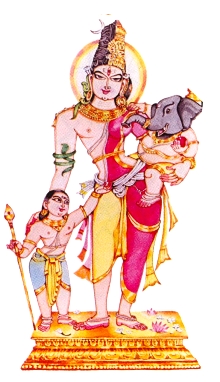 with the Supreme.When we say, maatR^i devo
bhava; maatR^i devo bhava;aacharya
devo bhava - it is not just
saluting the three, the mother, father and the tutor. These three,
put together, are available in Nataraja; say shiva - the father;
his half entity - the mother; and the guyru in his
dakshniNAmUrty variation. He is the
father in his naïve being, and the tutor when he is in the role of
guru, or dakshiNaamuurti and he is also the mother called
prakriti, lalitha, paarvati etc -
symolised just by left ear-hanging. Thus, the two kinds of ear
hangings of Nataraja emphasise that shiva is father-mother-guru.
This is his family.
with the Supreme.When we say, maatR^i devo
bhava; maatR^i devo bhava;aacharya
devo bhava - it is not just
saluting the three, the mother, father and the tutor. These three,
put together, are available in Nataraja; say shiva - the father;
his half entity - the mother; and the guyru in his
dakshniNAmUrty variation. He is the
father in his naïve being, and the tutor when he is in the role of
guru, or dakshiNaamuurti and he is also the mother called
prakriti, lalitha, paarvati etc -
symolised just by left ear-hanging. Thus, the two kinds of ear
hangings of Nataraja emphasise that shiva is father-mother-guru.
This is his family.
There is a cobra creeping around his neck, upper arms, or chest. This snake is called kuNDalini. The serpent represents a coiling power, kuNDalini shakti; kuNDala = coiling, shakti = power; the innate power of any being. Physiologically this serpent is identified with the sympathetic and para-sympathetic nervous systems creeping along the vertebral column, or resting in a coiled form near at coccyx. The insignia of allopathic medicine may be remembered wherein two serpents entwine a trident like spear. This innate power is the one that keeps the system working by its coiling and uncoiling powers. Yoga, a physio-psychological system has vastly enriched in its tenets basing on this kuNDalini shakti, and brought into real life many of the hidden practices of good and great living.
A holy thread hangs from the left shoulder to the downside of right flank, called yaj~nopaviitam symbolising the Purity of Being. This thread is the basic requirement to perform a Yajna, a Holy Vedic ritual, performed for the purification of inner self as well as the society at large. Any person without this thread is not eligible to perform certain rituals. Thus the Supreme Being is attributed with the right to perform Universal Rituals, may it be creation and dissolution or maintenance of the Universe, He has the authority to perform them.
This sacred thread reminds them who wear it, to live a purified life and undertake a holy attitude towards his own living and that of others.
Nataraja is depicted with four arms. It is the sculptor's way of
showing the personification of ambidexterity. He is not a person
nor a created being. He is no effect of any cause, but a cause in
himself. Thus his four arms are to be visualised for multitude of
works performed for the creation, maintenance and dissolution of
the universe. It is not like watching an octopus or a centipede,
but a cosmic entity who can perform omnifarious deeds.
created being. He is no effect of any cause, but a cause in
himself. Thus his four arms are to be visualised for multitude of
works performed for the creation, maintenance and dissolution of
the universe. It is not like watching an octopus or a centipede,
but a cosmic entity who can perform omnifarious deeds.
In the upper right hand there is a drumming instrument called Dhakka or Damaru. It is a double sided drumming instrument which gives out sonorous rhythm, too devastating to contain. Nataraja sounded it for fourteen times resulting in creation of roaring and thundering sonic boom in the skies, which in turn created the Universe. This drum is the symbol for the entire creation and perhaps the much discussed Big Bang might have emanated from this drum beat. In this sonic boom, dhwani, there emerged root sounds of aa, ii, uu etc., wherefrom the first letter a of Sanskrit is taken by mankind. Thus Nataraja is called naada brahma. This letter is common across universal languages, say Alpha of Greek or A of English or Aleef of Arabic or any other first letter. It is from this dhwani, the sonic boom, the Vedas etc., have emerged. Thus Natataja's hand still bears that drum lest the uttered word is not dead.
The left upper hand holds Eternal Fire. He is already surrounded
by devastating cosmic fire, then why handling this fire like a
torchlight... This handheld fire is the essentail principle of
life,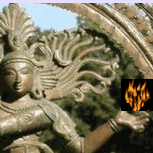 with which everything transforms, either biological bodies to
ashes, or seawater to raincloud etc. The process called Five-Fire
Process, pancha agni vidya stems from
this fire alone, which in a rudimentary way is this:
with which everything transforms, either biological bodies to
ashes, or seawater to raincloud etc. The process called Five-Fire
Process, pancha agni vidya stems from
this fire alone, which in a rudimentary way is this:
When humans on earth oblate watery substances like curds, ghee, milk, or at least water for gods, gods receive it and in turn oblate it in the celestial fire, called dyu loka agni, mixing with soma, the nectarious principle. Again when gods oblate that nectarian soma into parjanya agni, fire in raincloud, it becomes rain, and showers the same in the fire of earth, bhuumi agni, whereby earth yields food. Then the gods oblate that food in the fire of males, puruSha agni, i.e., they destine males to consume that particular food with nectarian principle in it, which gets transformed as a fruitful seminal fluid in males. And fianlly the same gods oblate the same fruitful fluid, via their fortunate males, in the fire of females called yoShita agni, whereby that soul which originally oblated liquids to gods takes birth as an offspring of that couple. Thus the cycle of birth and death becomes continuous.
This eternal fire keeps on burning from birth to death, causes Five-Fire Process, and thus it keeps the Universe on its wheel, as such shiva holds it, rather controls it.
The lower right hand is called abhaya hasta, the blessing hand, symboling safe existence. The creation shall exist till its sojourn is complete, which is blessed with this hand.
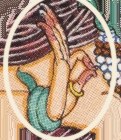 Apart
from abhaya-mudra, hand-gesture during
dance, j~naana -mudra,
hand-gesture of gnosis, is also depicted indicating shiva's
stature as supreme guru, dakshiNamurty.
Apart
from abhaya-mudra, hand-gesture during
dance, j~naana -mudra,
hand-gesture of gnosis, is also depicted indicating shiva's
stature as supreme guru, dakshiNamurty.
The dance-gesture, mudra of left lower
hand is called Dola hasta, a munificent
hand. This gesture indicates that benefits of living are bestowed
as well as the benefit of dying, i.e. moksha,
final liberation,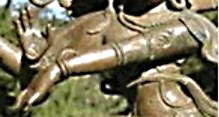 from the cycle of birth and death, if the seeker is a correct
knower of truth. Hinduism has no fanatic beliefs in religion.
Hinduism itself is not an ardent religion, but it is a
dharma, Way of Living. That is why a
correct knower of the truth is required rather than a fanatic
follower. Bhagavat Gita, the Divine Song, also says this. For that
matter, every Hindu script iterates this: "just KNOW me, you are
absolved of the birth-death cycle." So, an honest seeker will get
all he wants, not material gains, but spiritual upliftment, from
this Dola hasta.
from the cycle of birth and death, if the seeker is a correct
knower of truth. Hinduism has no fanatic beliefs in religion.
Hinduism itself is not an ardent religion, but it is a
dharma, Way of Living. That is why a
correct knower of the truth is required rather than a fanatic
follower. Bhagavat Gita, the Divine Song, also says this. For that
matter, every Hindu script iterates this: "just KNOW me, you are
absolved of the birth-death cycle." So, an honest seeker will get
all he wants, not material gains, but spiritual upliftment, from
this Dola hasta.
The posture of right leg is called sthita
padam, firm foot, firmly staying on its ground, meaning
that the Supreme Being is Omnipresent.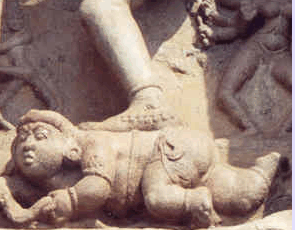 There is a dying demon underneath this firm foot. He is a dwarf
demon representing Rug, jwara, maraNa;
i.e., Rug= rugmata, roga = disease;
jwara = fever, any febrile condition ;
maraNa = death, decay; which are
natural to the living beings, but most cruel at the same time.
There is a dying demon underneath this firm foot. He is a dwarf
demon representing Rug, jwara, maraNa;
i.e., Rug= rugmata, roga = disease;
jwara = fever, any febrile condition ;
maraNa = death, decay; which are
natural to the living beings, but most cruel at the same time.
To get rid of these evils, the demon is to be suppressed by the Supreme Being who created them along with the living beings. Living itself is a disease.
Notice that the demon is not dead under the thumping right foot of that powerful Supreme Being. That demon is suppressed, because living without these evils will tantamount living in heaven, which is promised only to the correct Knower, but not to all. This may be called the Spiritual Realism.
The posture of left leg is just raised from the ground, as a dance
posture, and this foot is termed as anugarha
pada or moksha pada, bestowing foot. In Indian culture saluting to the feet of elders
or teachers is a symbolic representation of utter submission to
elders. It is not like the kneeling posture of subjects at a
throne or a monarch. Nataraja's raised left foot is made available
to the seekers for salutation in order to obtain knowledge of the
Supreme Being and thereby to get moksha, he salvation.
bestowing foot. In Indian culture saluting to the feet of elders
or teachers is a symbolic representation of utter submission to
elders. It is not like the kneeling posture of subjects at a
throne or a monarch. Nataraja's raised left foot is made available
to the seekers for salutation in order to obtain knowledge of the
Supreme Being and thereby to get moksha, he salvation.
Nataraja will be shown either naked, digambara, means one who has quarters as his dress, or in a tiger's skin, or in an elephant's skin. This depiction is, viirata chihna, symbol of Omnipotence. He has chains of small ringing bells decorated at his ankles, thighs, waist, wrists etc., producing lilting sounds.
His Cosmic Dance in its totality is called pancha kriya shakti; pancha=five; kriya=functions; shakti= power; i.e. the absolute power to make the function of any pentad, say the creation of five elements of nature, pR^ithivi, aapa, teja, vaayu, aakaasha, viz. solidity, liquidity, fire, ether, air; or, to make the functioning of five sensory organs to work; or, the power to maintain pancha-agni-vidya... etc.
Unlike dialectical materialism, spiritualism needs some spiritual power as " a priori ", which does all the creation, maintnance and dissolution of the universe. Thus, the pancha kriya shakti is vested with Nataraja.
